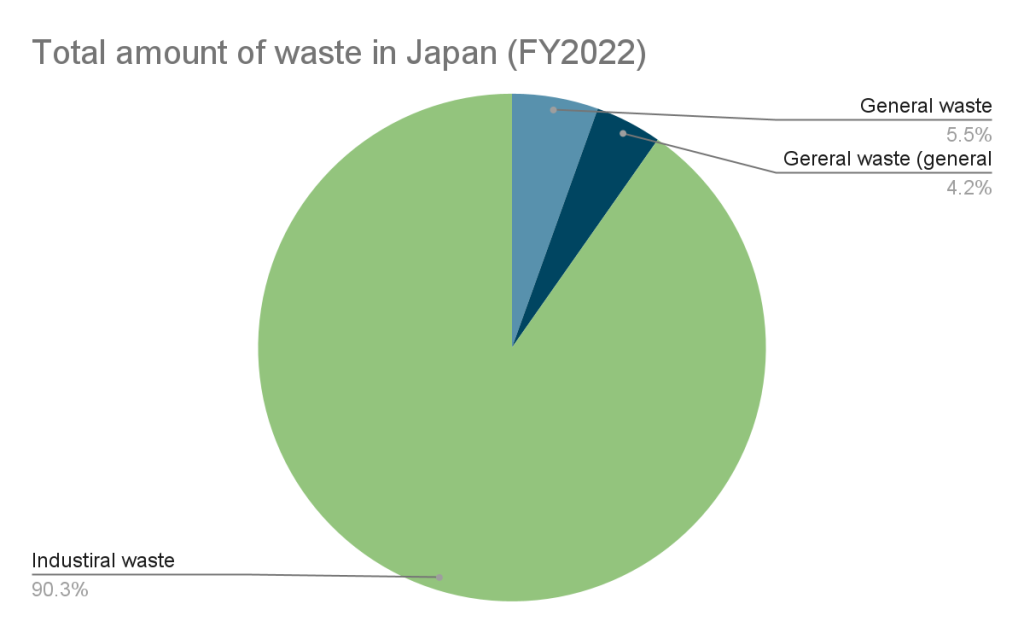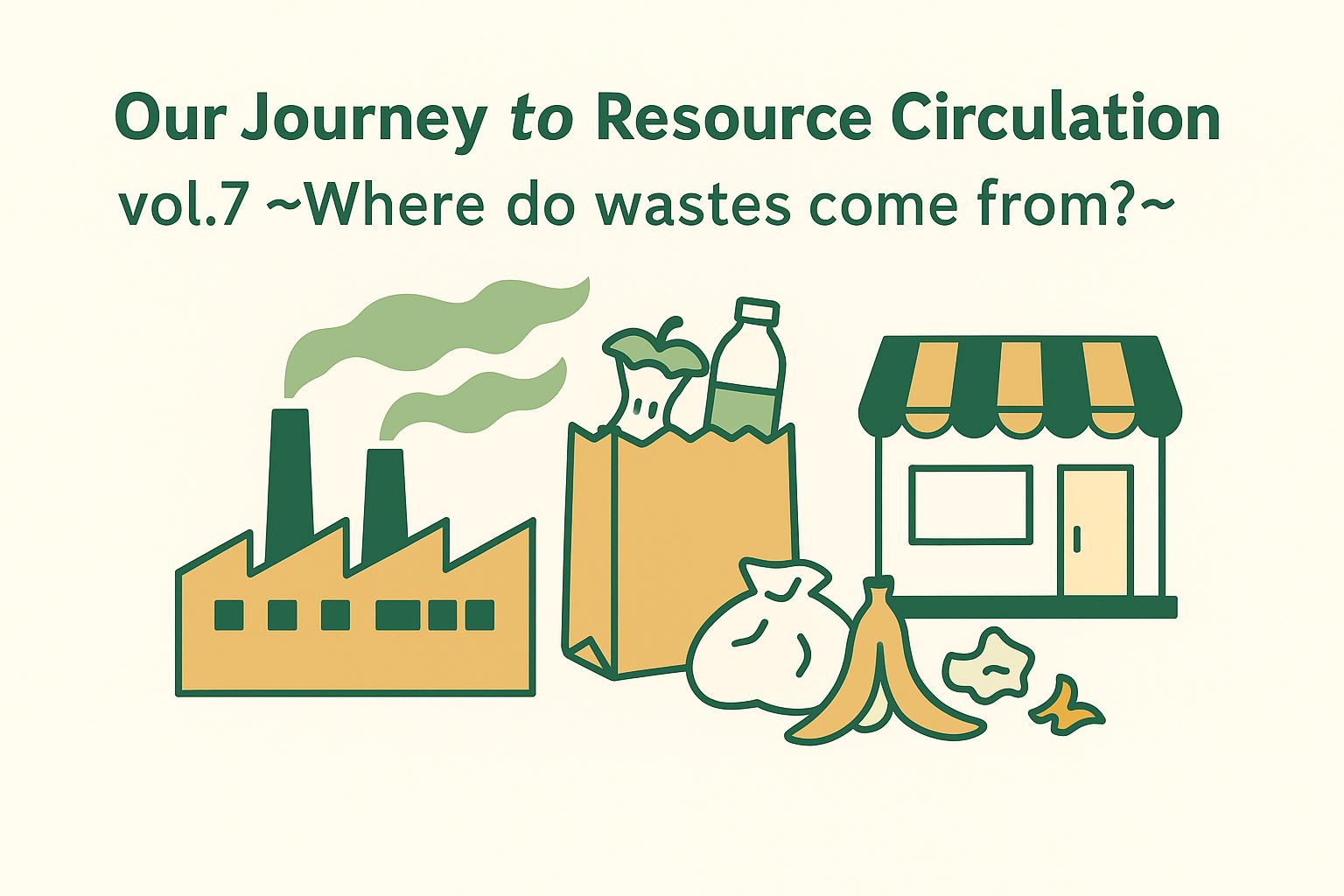In previous columns, we have looked at the resource recycling perspective, looking at how much recyclable “waste” is generated every day and the process by which that waste is recycled. This time, we will focus on the “sources of waste.”
1. Where do wastes come from? – Household and business waste –
There are two main types of waste sources: general waste and industrial waste.
“Household waste” among general waste refers to one generated in the daily lives of ordinary households. This includes food waste, paper scraps, plastic containers and packaging, cloth, bottles and cans, etc. Sorting rules and designated bag systems have been established, and residents dispose of waste in accordance with the established rules. Local governments are then responsible for collection and disposal. “Business waste (business general waste)” among general waste refers to one generated from business activities (stores, offices, restaurants, schools, hospitals, etc.) that does not fall under the category of industrial waste. This includes paper waste from offices and food waste from restaurants. Businesses are generally responsible for disposal themselves, so they either take it to the city’s waste disposal facility themselves or entrust it to a city-licensed company for collection and disposal. On the other hand, “industrial waste” refers to one generated in the course of business activities that falls under the 20 types (plus government ordinance-designated waste) specified in the Enforcement Order of the Waste Management and Public Cleansing Act. It mainly covers waste generated in large quantities and with special properties at factories, construction sites, manufacturing industries, etc. Businesses that generate waste are required to dispose of it at their own responsibility.
Table 1. Waste classification in Japan
*Based on the Waste Disposal and Public Cleansing Act (Waste Disposal and Public Cleansing Act). Classified by source and nature.
| Classification | Main sources of wastes | Responsibility for processing | Main processing entity | Representative contents |
| General waste (household waste) | family | City/town/village | autonomous region | Kitchen waste, paper, cloth, bottles, cans, etc. |
| General waste (business) | Shops and offices | The business owner himself | Consignment or self-delivery | Paper waste, packaging materials, food waste |
| industrial waste | Factories, construction sites, etc. | The business owner himself | Licensed processor | Sludge, waste oil, rubble, scrap metal, etc. |
2. Current status of business waste
According to statistics from the Ministry of the Environment, the total amount of waste generated across Japan in fiscal year 2022, including industrial and general waste, was approximately 410 million tons.
- General waste: Approximately 40.34 million tons
- Household waste: Approximately 22.75 million tons
- General business waste: Approximately 17.59 million tons
- Industrial waste: Approximately 374.07 million tons

Figure 1. Total amount of waste in Japan (FY2022)
It is clear that waste from business activities is overwhelmingly greater than household waste. In order to realize a resource-circulating society, it can be said that in addition to sorting and recycling at home, it will become increasingly important to reduce business waste and promote recycling.
According to the Ministry of the Environment’s “Status of Industrial Waste Discharge and Treatment (2022),” the total amount of industrial waste (including waste from business activities) discharged across Japan is approximately 374 million tons. approximately 226.9 million tons of the industrial wastes was recycled, with a recycling rate of approximately 54.2%. The amount of waste sent to final disposal is approximately 9.02 million tons (2.4%). These figures show that much of the industrial waste undergoes intermediate treatment.
On the other hand, although recyclable materials such as paper waste, plastics, cans, and bottles contained in business waste within general waste are generated in small quantities, their resource value makes them key to a circular economy. Paper waste and recovered paper are generated in large quantities by printing, publishing, and offices. High-quality office paper and cardboard are used as raw materials for recycled paper, and there is high demand for recycling. Plastic waste primarily consists of packaging, but recycling can be difficult if it is mixed with dirt or composite materials. Furthermore, glass waste and ceramics (including bottles) can be reused, but collection and sorting are time-consuming and costly. These materials have great potential for recycling if they are thoroughly separated and quality is maintained.
3. Potential for resource recycling
In order to treat business waste as a resource rather than just waste, efforts must be made from multiple perspectives.
The Japanese government has established laws that require businesses to properly dispose of waste and promote the recycling of plastic resources.
- Law that stipulates how businesses should handle waste disposal
- Waste Disposal and Public Cleansing Act (Waste Disposal and Public Cleansing Act):
Businesses are responsible for properly disposing of waste generated in their business activities (responsibility of the waste generator). Responsibility cannot be absolved even when outsourcing. - Plastic Resource Recycling Promotion Act (enforced in 2022):
This comprehensive law requires businesses to promote the 3Rs (Reduse, Reuse and Recycle) of plastics, resource circulation design, waste reduction, sorting, and recycling. It is being implemented through coordination with local government plans.
- Waste Disposal and Public Cleansing Act (Waste Disposal and Public Cleansing Act):
For example, in recent years, an increasing number of local governments have enacted ordinances that prohibit the inclusion of waste paper in burnable wastes. These sorting rules are becoming more widespread, especially among individual households. On the other hand, support for corporations is still in its infancy. Under this situation, some designated cities have already begun to make it mandatory to recycle business waste paper, and therefore there is a growing movement to require companies to separate waste paper and secure collection routes.
Table 2. List of local government cases where businesses have made recycling of waste paper mandatory or prohibited it from being brought in
Looking at examples of local governments like the cases above, they have introduced mandatory and ban-on-delivery systems. However, there are still many cases where separation is mandatory (regulations requiring businesses to separate waste) and there is a de facto ban on bringing waste in (regulations requiring businesses to separate waste). Only a limited number of local governments have introduced the set of measures (i.e. waste cannot be brought to a treatment facility and cannot be incinerated), and we believe that there is still untapped potential for further resource recycling.
Furthermore, the current trend of a yearly decline in the number of clean centers (waste incineration facilities) is also likely to drive business waste recycling. Nationwide, clean centers (waste incineration facilities) are being consolidated while their number is decreasing. According to data from the Ministry of the Environment, the number of incineration facilities nationwide was 1,004 in fiscal year 2023, a decrease of approximately 10% from 10 years ago. Meanwhile, the processing capacity per facility has been increasing year by year, and there has been a shift toward “fewer, more efficient facilities” through measures such as expanding the area and introducing high-efficiency power generation functions. This trend is driven by a decline in waste emissions due to population decline and the increasing costs of aging and upgrading facilities. The same situation is occurring in Hyogo Prefecture, where as of fiscal year 2021, there were 33 facilities with a processing capacity of approximately 8,230 tons per day, a decrease of nearly 30% since the 1990s. Among 33 facilities, 18 facilities are equipped with power generation facilities, with a total generating capacity of approximately 113,000 kW. While efficient operation is progressing, the reduction in the number of facilities makes the “sorting of waste for incineration” increasingly important.
Under these circumstances, it is necessary to further promote the recycling of business waste, which has previously been incinerated. In particular, waste paper, plastic, cans, and bottles from offices and stores have high potential for recycling, making them the most effective way to reduce incineration. Because facility consolidation creates limits on the amount of waste that can be burned, recycling becomes a necessary initiative rather than an option. The consolidation of clean centers is not just a reduction, but a turning point that changes the social system from incineration to recycling. This is an opportunity for businesses, local governments, and collection companies to work together to accelerate recycling throughout the region.
4. Future Outlook: The Role of Social Bridge/Matsuzawa
Taking into account these government trends, active efforts are also required from the business side, which is the actual source of emissions. By implementing initiatives to promote recycling, such as thorough sorting of recyclable business waste, securing collection routes, and taking quality improvement measures such as thorough cleaning and pre-treatment to prevent contamination and foreign matter, we can improve the quality of business waste and pave the way for a resource-circulating economy.
Social Bridge/Matsuzawa plays a central role in this cycle of “business waste to resources” through its paper and waste collection business. Cooperation between collection businesses and waste producers to produce high-quality resources is the key to realizing a recycling-oriented society. As a “bridge” in this regard, Social Bridge/Matsuzawa sees waste as a “beginning” rather than an “end,” and creates new resource flows within the local community.
Waste generated from homes, factories, and offices ultimately contributes to the resource circulation of society as a whole. Changing the act of throwing away into a mindset of passing on to the next generation is the first step towards building a sustainable future. Social Bridge/Matsuzawa will continue to work with businesses, local communities, and society to expand the circulation that makes use of resources.
<List of references and sources>
- Ministry of the Environment “General waste discharge and treatment status (2022)” press release
- Ministry of the Environment “Industrial waste discharge and treatment status (FY2022 results)” press release
- Ministry of the Environment “Survey on the Actual State of General Waste Disposal Business (2022)” Statistical Data (e-Stat)
- Osaka City”Prohibition of transporting recyclable paper to incineration plants” (Osaka City Environment Bureau)
- Nishinomiya City (Hyogo Prefecture)”Prohibition on the Delivery of Business Waste Paper” — A ban on the delivery of recyclable waste paper will be implemented from January 4, 2025 —
- Fukuoka City”Waste paper added to the classification of general business waste” — Effective October 1, 2020 —
- Sakai City”How to Promote Paper Recycling in Businesses” – System for Promoting Recycling of Paper Discarded from Businesses –
- Amagasaki City (Hyogo Prefecture)”How to separate and dispose of waste from businesses, stores, etc. (business waste)” — Waste paper (newspapers, cardboard, magazines, office paper, etc.) cannot be brought to the Clean Center; entrusting it to a resource recovery company is recommended —
- Ministry of the Environment “Status of Waste Treatment Facilities (Reiwa 5 Edition)”
–Data on the number of clean centers (incineration facilities), power generation equipment ratio, and processing capacity– - Public Interest Incorporated Foundation for the Promotion of Industrial Waste Management “Outline of Industrial Waste Discharge and Treatment Status (2022 Results)”
- Hyogo Prefecture, Environment Department, Environmental Improvement Division, “List of Hyogo Prefecture Waste Treatment Facilities (Reiwa 3rd Edition)”
- Hyogo Prefecture’s “Proper Waste Disposal and Recycling Promotion Plan (2021)”
- Kobe City “Rules for business waste disposal, list of prohibited items, and designated bag system”
- Ministry of the Environment “Waste Disposal and Public Cleansing Act (Waste Disposal and Public Cleansing Act)”
- Ministry of the Environment “Plastic Resource Recycling Promotion Act” summary document

